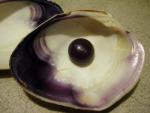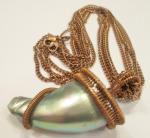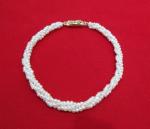GIA Tests 3 Large Hollow Natural Pearls
Three Large Natural Hollow Pinctada radiata Pearls
Recently, three large baroque natural hollow pearls
reportedly from the Pinctada radiata species were
submitted for scientific examination at GIA’s Mumbai
laboratory. According to the owner, the pearls were
obtained from Bahraini divers more than a decade ago.
Weighing 1.97, 3.92, and 6.13 ct, and measuring 10.09 ×
8.40 × 6.32 mm, 12.78 × 11.12 × 9.45 mm, and 16.00 ×
13.94 × 11.60 mm, respectively, these pearls had surprisingly low heft for their sizes (figure 10). Their purplish
gray bodycolor, with varying tones of orient, displayed
brown patches of different intensities.
Under high magnification, the gray areas exhibited a
fine striated nacre growth pattern of overlapping platelets
typical of nacreous pearls from Pinctada species. Small
areas on pearls 1 and 2 displayed a distinctive spiral platy
structure, with the translucent outer nacre revealing layers
of resinous organic-rich material. In addition, dull
brownish patches with a crackled surface texture and a
bumpy botryoidal appearance were observed in pearls 1 and
3, surrounded by minor surface blemishes. All three pearls
exhibited an inert reaction when subjected to X-ray
fluorescence. Energy-dispersive X-ray fluorescence spectrometry showed no traces of manganese and higher
strontium levels of 853, 973, and 1013 ppm, respectively,
indicative of a saltwater environment. When viewed under
long-wave ultraviolet radiation, the pearls showed a moderate bluish green reaction (figure 11) and a similar weaker
reaction under short-wave ultraviolet radiation.
Notably, many antique pearl jewelry pieces dating
before the twentieth century, prior to the start of pearl
cultivation, feature large hollow natural pearls. These
hollow natural pearls were often too fragile to set on jewelry and were frequently filled with metal fragments to
increase both their durability and weight. Despite their
significant size, hollow pearls are deceptively light. It is
quite common for natural pearls to exhibit a hollow
structure. The exploration of such pearls has consistently
captivated gemologists, as their intricate and complex
internal structures pose challenges in drawing definitive
conclusions, with similar voids occasionally observed in
NBC pearls. The study of such specimens provides
valuable insights and significantly contributes to our
understanding of the formation processes associated with
natural hollow pearls.
Read entire article starting on page 178 in SOURCE link below.
GIA 7 Pearl Value Factors: An update on nacre classification
Pearls, both natural and cultured, form in a wide
variety of sizes, shapes, and colors. This diversity created
the need to distinguish their various appearances, characteristics, and a host of other complex factors that contribute
to determining quality, desirability, and ultimately, value.
Researching and studying pearls since the 1930s, GIA developed the GIA 7 Pearl Value Factors classification system, a
systematic approach to evaluate a pearl’s various quality
factors through consistent methodology and common terminology (J.W.Y. Ho and S.C. Shih, “Pearl classification:
The GIA 7 Pearl Value Factors,” Summer 2021 G&G, pp.
135–137). The system, which has been widely adopted in
the pearl industry, classifies pearls according to size, shape,
color, luster, surface, nacre, and matching.
Nacre formation plays a critical role in pearl growth, as
its structure influences other value factors such as size,
shape, luster, and surface quality. Nacre thickness and continuity also affect a pearl’s durability. Prior to this update, a
grade of Acceptable denoted expected commercial quality
standards, while Unacceptable indicated poor-quality nacre
that may impact durability.
Read entire article in SOURCE link below starting on page 210.
SOURCE: https://www.gia.edu/doc/summer-2025-gems-gemology.pdf
Join in and write your own page! It's easy to do. How? Simply click here to return to Pearl News.





